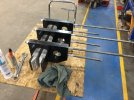Can you expand on this? Are you saying that nobody produces 'coaster-scale' LSMs capable of that, or that its downright impossible at any scale. I don't buy the latter...

Please note that I am just talking about current technology. If we are able to build stable superconducters at operating temperatures of a rollercoaster one day, the theoretical acceleration is unlimited, as long as you can provide the electricity.
With current technology, it is in theory possible to reach 100m/s², but as far as I know really only in theory.
A LSM module is basically nothing else than an rolled out electric motor. Both themself don't provide a fixed acceleration, but a force which in turn can accelerate an object. In case of a rollercoaster, the magnetic field interacts with the magnets under the train, resulting in a force towards a certain direction. This force will then accelerate the train in this direction. Through switching the polarities of the LSM modules, you ensure that the force keeps pulling and pushing the train forward, instead of fixing it to a certain position.
Anyway, the force itself does not equal a certain acceleration, unless you take the weight of the train into account. Whilst the train will always move when a force is applied to it, the acceleration is depending on its weight. The lighter the train for a given force, the higher the acceleration.
In addition, applying more power to the modules will increase the strengths of their magnetic field and therefore the thrust produced. This results in higher heat production, and may lead to overheating.
But yes, in theory a very light object could be accelerated with 10g and beyond using LSM motors. Halving the weight of an object will actually result in more then a doubling of the theoretical acceleration, as you don't have to run the motors as long and therefore allowing for a higher current.
If you would lenghten the train, you can apply more force to it as the LSMs are running more efficient, but you also increase the weight. In the end, a longer train will always result in lower acceleration than a shorter one, as each module has to be active for a longer period of time, reducing the energy per traincar.
Of course you could simply add more magnets. This can be done until the space underneath a car is completely used by magnets, but it dies not give a linear increase in acceleration. Doubling the magnets (and therefore LSM modules) will result in a higher acceleration, but the magnets also add some weight, and from what I know, those things are heavy.
Current LSM modules might hit 2g peak acceleration for a very short period of time on a train, but even if Intamin/Indrivetec (who have the highest per module acceleration) would triple the amount of LSM modules, it would still result in an acceleration of "just" ~4g for any remotely longer amount of time (we are talking about less than a second here).
10g with LSM is, as of now, simply not possible for a rollercoaster. The trains are too long, too heavy, and the amount of electricity required might also be too high.



